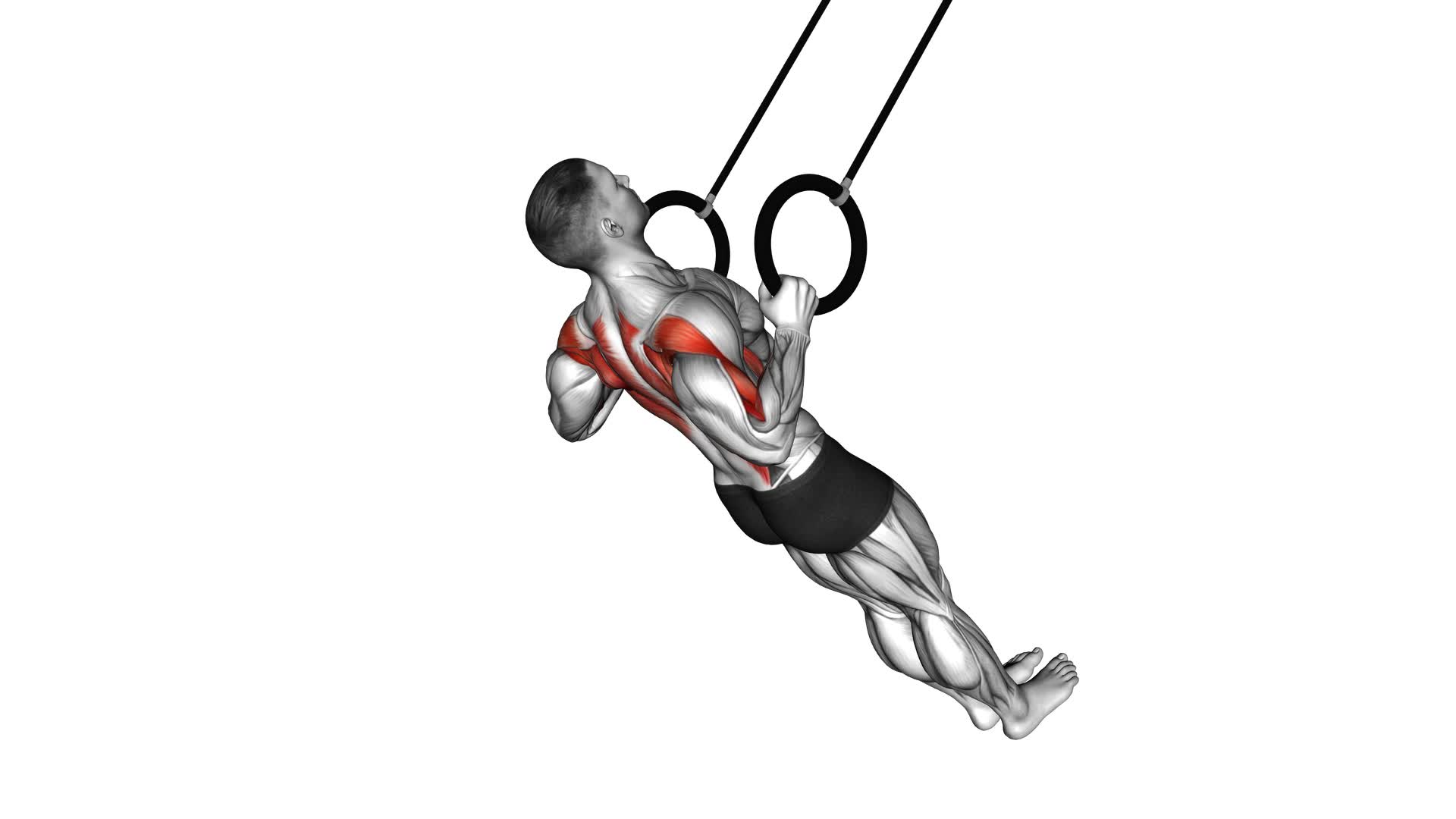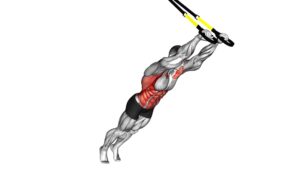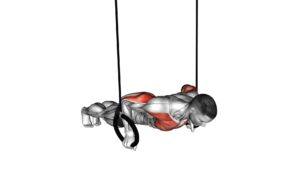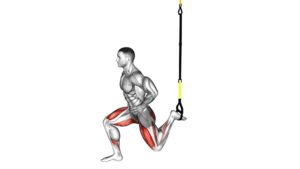Suspended Row – Video Exercise Guide & Tips

Are you looking to improve your upper body strength?
Watch This Exercise Video
In this video exercise guide, we'll show you how to perform suspended rows effectively.
With just a few pieces of equipment, you'll be able to target your back and arms, increasing muscle tone and definition.
Follow our expert tips and watch the video demonstrations to ensure proper form and technique.
Get ready to take your fitness routine to the next level with suspended rows.
Key Takeaways
- Engages multiple muscle groups including the back, shoulders, and arms
- Improves posture by countering the effects of sitting and hunching over
- Alleviates back pain and promotes a more upright posture
- Builds strength and muscle development in the upper body
Benefits of Suspended Rows
Experience the numerous benefits of suspended rows for a stronger and more toned upper body. Suspended rows, also known as inverted rows or body rows, offer a range of health benefits and contribute to muscle development. This exercise primarily targets the muscles in your back, shoulders, and arms, helping you achieve a well-defined upper body.
One of the key health benefits of suspended rows is improved posture. By engaging the muscles in your upper back and shoulders, this exercise helps to counteract the effects of sitting for long periods and hunching over electronic devices. Regularly incorporating suspended rows into your workout routine can help alleviate back pain and promote a more upright posture.
In addition to improving posture, suspended rows are effective for building strength and muscle development in the upper body. This exercise engages multiple muscle groups, including the latissimus dorsi, rhomboids, trapezius, and biceps. By challenging these muscles, suspended rows help to increase overall upper body strength and create a more defined and toned physique.
To maximize the health benefits and muscle development from suspended rows, it's important to maintain proper form and technique. Keep your body aligned and core engaged throughout the exercise. Gradually increase the difficulty by adjusting the angle of your body or adding resistance. Remember to incorporate proper warm-up and cool-down exercises to prevent injury and make the most out of your suspended row workout.
Equipment Needed for Suspended Rows
To perform suspended rows effectively, you'll need some essential equipment. This includes suspension straps or a suspension trainer, a stable anchor point such as a door or a sturdy bar, and comfortable hand grips.
If you don't have access to suspension equipment, you can also try alternatives like resistance bands or TRX-style straps. It's important to use proper equipment to ensure safety and maximize the effectiveness of your suspended row workout.
Essential Equipment for Rows
You will need essential equipment for suspended rows. Here are the items you'll need to perform this exercise effectively:
- Suspension Trainer: This is the main piece of equipment that allows you to perform suspended rows. It consists of adjustable straps that can be attached to a stable anchor point, such as a doorframe or a sturdy beam.
- Handles or Grips: These are the attachments that you'll hold onto while performing the rows. There are different types of handles available, such as straight handles or ergonomic grips, so you can choose the one that feels most comfortable for you.
- Door Anchor: If you don't have a suitable anchor point, a door anchor can be used to attach the suspension trainer to a closed door. This allows you to perform the rows in any room with a sturdy door.
Now that you know the essential equipment needed for suspended rows, let's explore some alternatives to suspension equipment.
Alternatives to Suspension Equipment
If you don't have access to suspension equipment, but still want to perform suspended rows, there are alternative options available.
One alternative is using a Smith machine or a power rack. These pieces of equipment have a barbell attached to a fixed track or frame, allowing you to adjust the height and perform rows.
Another option is using resistance bands. They can be attached to a sturdy anchor point, such as a door or a pole, and used to mimic the movement of a suspended row.
The advantages of these alternatives are that they're easily accessible, cost-effective, and can still provide a challenging workout for your back and arms.
However, it's important to remember that proper equipment is essential for safety and effectiveness.
Importance of Proper Equipment
Having the right equipment is crucial for performing suspended rows effectively and safely. Proper equipment selection and following safety precautions are essential to ensure a successful workout.
Here are three key items you'll need for suspended rows:
- Suspension Trainer: Invest in a high-quality suspension trainer that can support your body weight and provide stability during the exercise. Look for adjustable straps and sturdy handles for maximum comfort and safety.
- Anchoring Point: Find a secure and stable anchor point, such as a sturdy beam or bar, to attach your suspension trainer. Make sure the anchor can support your weight and won't move or break during your workout.
- Safety Measures: Before starting your suspended rows, take safety precautions by checking the integrity of your equipment, including straps, buckles, and carabiners. Always perform a thorough warm-up and listen to your body to prevent injury.
With the right equipment in place, you can now move on to learning the proper form and technique for suspended rows.
Proper Form and Technique for Suspended Rows
To perform suspended rows with proper form and technique, it's crucial to focus on correct body positioning, grip, and hand placement.
Ensure that your body is in a straight line from head to heels, engaging your core and glutes throughout the exercise.
Maintain a firm grip on the handles, with your palms facing each other and your wrists in a neutral position.
Lastly, remember to breathe properly, inhaling as you lower your body and exhaling as you pull yourself up, maintaining control and stability throughout the movement.
Correct Body Positioning
Position your body correctly to maintain proper form and technique while performing suspended rows. This will ensure the most effective workout and minimize the risk of injury. Here are three important aspects to focus on:
- Body Alignment: Stand facing the anchor point with your feet hip-width apart. Keep your spine straight and shoulders pulled back. Engage your core muscles to stabilize your body throughout the exercise.
- Muscle Engagement: Before you start pulling yourself up, activate your back muscles by squeezing your shoulder blades together. This will ensure that you're primarily targeting your back muscles during the rowing motion.
- Proper Breathing: Inhale as you lower your body towards the ground and exhale as you pull your body back up. This rhythmic breathing pattern will help you maintain control and stability during the exercise.
Grip and Hand Placement
How should you grip and place your hands for proper form and technique in suspended rows?
Grip strength and hand placement are crucial elements in performing suspended rows correctly. To ensure a secure grip, wrap your fingers around the handles, making sure to maintain a firm hold throughout the exercise.
The position of your hands can vary depending on your preference and comfort level. One technique is to use an overhand grip, where your palms face down and your fingers wrap over the handles. Another option is an underhand grip, with your palms facing up and your fingers wrapping under the handles.
Experiment with different hand placements to find the one that feels most natural to you. Remember to engage your grip strength and maintain proper form throughout the exercise for optimal results.
Breathing During Exercise
Maintain proper breathing technique throughout suspended rows to optimize your form and results. Proper breathing techniques not only enhance your performance during exercise but also provide respiratory benefits.
Here are three important tips for breathing during suspended rows:
- Breathe in during the eccentric phase: As you lower your body towards the ground, inhale deeply through your nose. This helps oxygenate your muscles and prepares them for the exertion.
- Exhale during the concentric phase: As you pull your body back up, exhale slowly through your mouth. This allows you to engage your core and maintain stability throughout the movement.
- Focus on controlled breathing: Avoid holding your breath or taking shallow breaths. Instead, aim for deep, rhythmic breaths that sync with your movements. This helps you stay focused, maintain energy, and prevent dizziness or lightheadedness.
Variations of Suspended Rows
To add variety to your suspended row workouts, try out different variations.
There are several row variations that you can incorporate into your routine, each targeting different muscle groups for a well-rounded workout.
One variation is the single-arm suspended row, which focuses on your back muscles, particularly the latissimus dorsi. By performing this exercise with one arm at a time, you can increase the intensity and challenge your muscles in a different way.
Another variation is the wide-grip suspended row, which targets your upper back and shoulders. By placing your hands wider than shoulder-width apart on the suspension straps, you engage more of your rhomboids and posterior deltoids.
Lastly, you can try the inverted row, where you position yourself underneath a suspension trainer and pull your body up towards the handles. This variation primarily works your back muscles, but also engages your biceps and core.
Incorporating these different row variations into your workouts won't only keep things interesting, but also help you develop strength and muscle definition in various areas of your upper body.
Tips for Getting the Most Out of Suspended Rows
To maximize the effectiveness of your suspended row workouts, incorporate these tips for optimal results:
- Proper Warm Up: Before starting your suspended row workout, it's essential to warm up your body. This helps to increase blood flow, loosen up your muscles, and prevent injuries. Consider performing dynamic stretches or light cardio exercises to get your heart rate up and prepare your body for the workout.
- Engage Your Core Muscles: Suspended rows primarily target your back muscles, but incorporating your core muscles can enhance the exercise. As you perform the rows, focus on engaging your abdominal muscles and maintaining a stable core. This not only helps to improve your posture but also adds an extra challenge to the exercise, giving you a more comprehensive workout.
- Vary Your Hand Positions: Changing your hand positions during suspended rows can target different muscles and prevent muscle imbalances. Try using an overhand grip, an underhand grip, or a neutral grip to work your back muscles from different angles. Experiment with different hand widths as well, such as a wide grip or a narrow grip, to engage different muscle fibers and promote overall muscle development.
Common Mistakes to Avoid When Performing Suspended Rows
Avoiding common mistakes is crucial when performing suspended rows to ensure proper form and prevent injuries.
One common mistake is using too much momentum. It's important to remember that suspended rows are a strength exercise, not a cardio workout. Using momentum not only reduces the effectiveness of the exercise, but it also increases the risk of injury.
Another mistake is improper grip placement. Your hands should be shoulder-width apart and positioned with your palms facing each other. Avoid gripping too tightly or too loosely as this can lead to discomfort or slipping, respectively.
Additionally, rounding your shoulders is a common mistake that can put unnecessary strain on your neck and upper back. Instead, focus on keeping your shoulders pulled back and down throughout the entire movement.
Lastly, neglecting core engagement is a mistake that can compromise your stability and limit the effectiveness of the exercise. Remember to engage your core by pulling your belly button towards your spine and maintaining a neutral spine position.
Frequently Asked Questions
How Many Sets and Repetitions Should I Do for Suspended Rows?
To determine the number of sets and repetitions for suspended rows, consider your fitness level and goals. Start with 3 sets of 8-12 reps, allowing 30-60 seconds of rest between sets.
As you progress, increase the number of sets or reps. You can also try different variations like wide grip or single-arm rows to target different muscle groups.
Remember to listen to your body and adjust accordingly for optimal results.
Can Suspended Rows Help Strengthen My Core Muscles?
Suspended rows can definitely help strengthen your core muscles. By engaging your core to maintain stability while performing the exercise, you're effectively targeting your abdominal muscles, obliques, and lower back.
The variations of suspended rows, such as single-arm rows or inverted rows, further challenge your core stability and enhance muscle activation.
In addition to core strength, suspended rows also work your upper back, arms, and shoulders, making it a great full-body exercise with numerous benefits.
Are Suspended Rows Suitable for Beginners?
Suspended rows offer great benefits for beginners. They allow you to modify the exercise to suit your fitness level, making it suitable for those just starting out. By using the suspension trainer, you can adjust the difficulty by changing your body angle and the level of resistance. This helps you build strength gradually and prevents injury.
Can Suspended Rows Help Improve My Posture?
Suspended rows are a great exercise to improve your posture. By engaging your upper back muscles, suspended rows help strengthen your back and shoulders, which can help correct any imbalances and promote better alignment.
Performing suspended rows with proper form and technique is crucial to maximize the benefits. Remember to keep your core engaged, shoulders pulled back, and elbows close to your sides.
This exercise is an effective way to enhance overall upper body strength and improve your posture.
How Long Should I Rest Between Sets of Suspended Rows?
To optimize your workout, it's important to consider rest duration between sets of suspended rows. Resting for around 30-60 seconds allows your muscles to recover while still maintaining intensity. However, the exact duration can vary depending on your fitness level and goals.
As you progress, you can decrease the rest time or increase the difficulty by trying different variations of suspended rows. This will challenge your muscles and help you achieve better results in improving posture.
Conclusion
In conclusion, suspended rows are a highly beneficial exercise that can be done with minimal equipment. By using the correct form and technique, you can target multiple muscle groups and improve your upper body strength.
There are also various variations of suspended rows that you can try to add variety to your workout routine.
Remember to follow the tips provided to get the most out of your suspended rows and avoid common mistakes.
Keep up the great work and enjoy the benefits of this effective exercise.

Author
Years ago, the spark of my life’s passion ignited in my mind the moment I stepped into the local gym for the first time. The inaugural bead of perspiration, the initial endeavor, the very first surge of endorphins, and a sense of pride that washed over me post-workout marked the beginning of my deep-seated interest in strength sports, fitness, and sports nutrition. This very curiosity blossomed rapidly into a profound fascination, propelling me to earn a Master’s degree in Physical Education from the Academy of Physical Education in Krakow, followed by a Sports Manager diploma from the Jagiellonian University. My journey of growth led me to gain more specialized qualifications, such as being a certified personal trainer with a focus on sports dietetics, a lifeguard, and an instructor for wellness and corrective gymnastics. Theoretical knowledge paired seamlessly with practical experience, reinforcing my belief that the transformation of individuals under my guidance was also a reflection of my personal growth. This belief holds true even today. Each day, I strive to push the boundaries and explore new realms. These realms gently elevate me to greater heights. The unique combination of passion for my field and the continuous quest for growth fuels my drive to break new ground.



